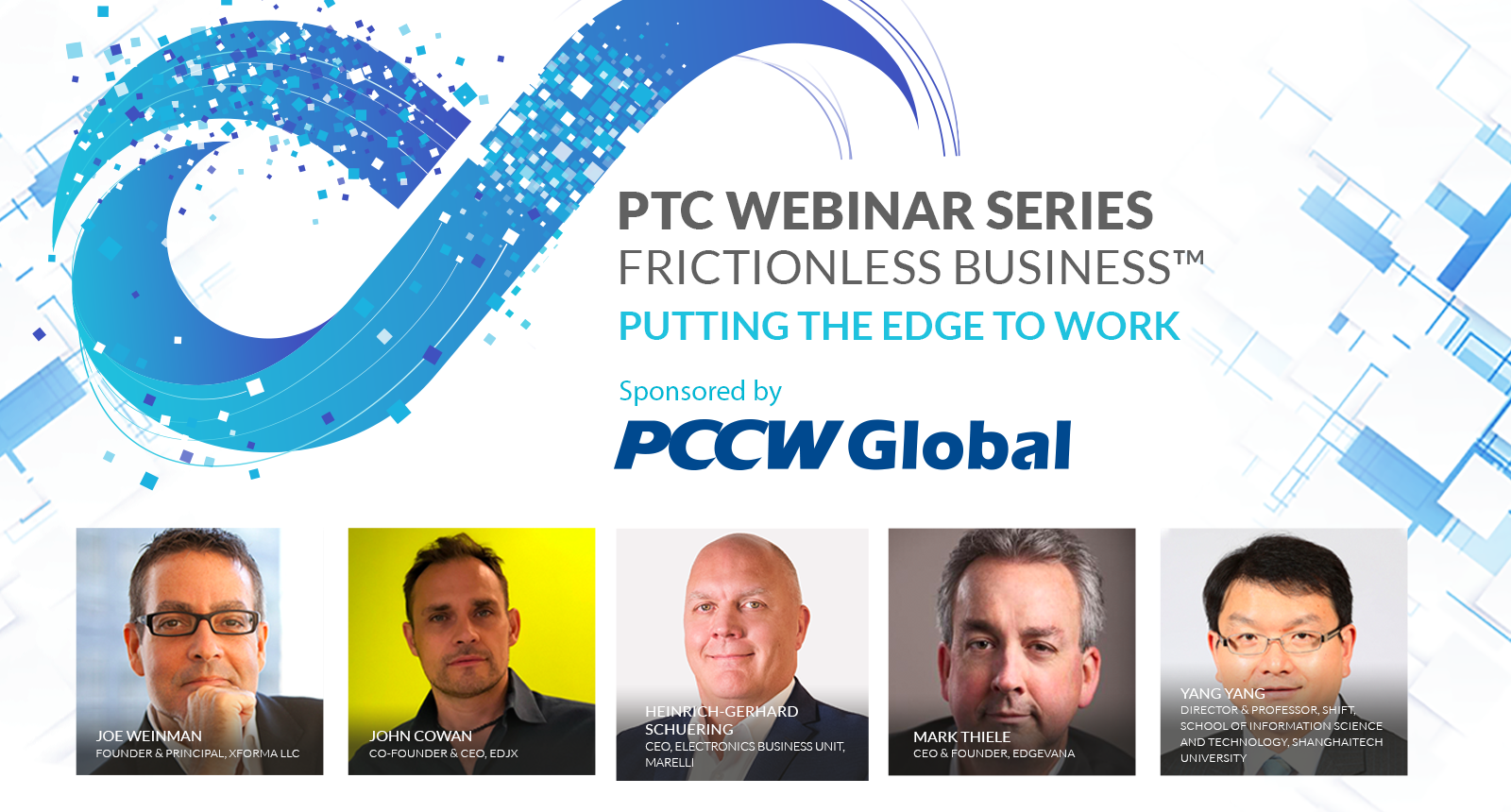The PTC Webinar Series: Frictionless Business™ kicked off its 2021 season with “Putting the Edge to Work,” featuring moderator Joe Weinman and panelists spanning the globe:
- John Cowan, Co-Founder & CEO, EDJX
- Heinrich-Gerhard (H-G) Schuering, CEO, Electronics Business Unit, Marelli
- Mark Thiele, CEO & Founder, Edgevana
- Yang Yang, Director & Professor, SHIFT, School of Information Science and Technology, ShanghaiTech University
This represented a broad mix of participants, not only geographically but also in terms of academia, start-ups and established enterprises, and infrastructure enablers, as well as customers of emerging information and communications technologies. Professor Yang heads research on 5G and edge at SHIFT, the Shanghai Institute of Fog Computing Technology; EDJX offers innovative technology for edge computing for use across multiple industries; Edgevana offers a marketplace to create a virtual global edge network; and Marelli is a multi-billion Euro auto parts manufacturer with over 40,000 employees. Its products range from intelligent vehicle safety systems, lighting, powertrain, etc., to specialized components for Formula One and Grand Prix motorcycle racing.
Joe Weinman opened the session by observing the industry evolution that was underway. In bygone years, it would be unusual to have an automotive company present at an event organized by the Pacific Telecommunications Council. Yet, today, nothing could be more appropriate, due to the confluence of global networks, cloud and edge computing, 5G, and intelligent distributed applications such as smart cities, supply chain optimization, and connected autonomous vehicles. In fact, in many ways, the “telephone handset” has evolved from wired to cordless to wireless to its latest variation: the automobile.
As John Cowan observed, this shift, more broadly considered as the Internet of Things (IoT), will be “the largest paradigm shift in the history of the Internet.” Rather than the Internet being merely about emailing spreadsheets to one another, we’ve entered the era of cyber-physical systems, where the real world is inextricably linked to the virtual one through networks and software. Moreover, the demands of ultra-low latency mean that processing nodes need to be present, in effect, on every street corner. Cowan argues that this inexorably leads to a need for multitenancy because, for example, no edge user can afford to build out a private infrastructure on every street corner that that infrastructure may be required. By analogy, no traveler can afford to own a house in every city that they may end up staying overnight.
Professor Yang supported the idea that 5G and edge are extremely complementary. After all, the ultra-low latencies of single digit milliseconds that 5G promises are meaningless if they are part of an end-to-end response time that adds 150 milliseconds of round-trip response time to a distant cloud. Applications such as smart cities and smart factories are examples he cited of initiatives receiving a high degree of attention in China.
Mark Thiele sees the edge in financial terms: the place where “you can bring appropriate technology together at the right cost to create a new business opportunity or solve a problem and still realize appropriate ROI.” This leads to applications such as real-time data analytics, emergency response, and entertainment and customer engagement for retail. He further points out that while latency is certainly critically important, another driver for the edge is economics: the cost of data transport to a far-away location, and the benefits of rapid insight or saving a life by preventing a vehicle collision.
Cowan said that these economics mean that the elements of a typical decision-making loop—sensors, processors, and actuators—must be located close to each other. Moreover, typically there isn’t a single sensor but rather a multitude, and “sensor fusion” is required to capture, integrate, and process the data for appropriate insights to be gained and decisions to be made.
H-G Schuering pointed out that emerging automotive, smart cities, and roadside infrastructure exemplify this. Even Formula One is putting immense computing power at the edge, albeit on private networks, to process the large amount of data collected on the track. He points out that autonomous vehicles need to do a substantial amount of onboard processing because one can’t rely on any external entity to, say, detect an impending collision and activate the brakes. On the other hand, you can’t just rely on onboard, disconnected activities because globally optimizing traffic flow, determining routing, and maximizing sustainability require a lot of data to stream into the car from information sources such as road mapping databases and from other vehicles, roadside infrastructure, and city traffic management operations. In short, massive amounts of data need to be delivered to and captured from each vehicle. These complexities are driving necessary shifts in organization and skill sets, from traditional competencies to systems and software design, and to a focus on different applications and different domains, such as safety, entertainment, powertrain, and so forth.
John Cowan noted that there are additional complexities in the mix, including rethinking how edge nodes cooperate through an edge network that is a peer-to-peer mesh, and Professor Yang added that understanding trade-offs between communications costs and computing costs, while also ensuring trust, security, and privacy, to which Cowan added governance and data immutability, which are especially critical in real-world situations, whether it be a car hurtling down the highway or a robot arm swinging quickly in a factory.
The discussion addressed many other topics: scalability of edge infrastructure and businesses, rethinking the industry ecosystem of the Internet, ensuring resource availability for mobile endpoints, future-proofing architectures, sandboxing, cryptography, skills development, digital transformation, partner and university development, design engineering and software development process acceleration, talent development, continuous integration, operating system design, edge computing implementation, SLAs, liability considerations, challenges due to the explosion of data, pervasive multilayer computing, and more.
In short, when we put the edge to work, there are limitless opportunities to pursue—and challenges that these global leaders are creatively overcoming.
See the entire webinar here:








